 Purdue University - Extension - Forestry and Natural Resources
Purdue University - Extension - Forestry and Natural Resources
Got Nature? Blog
Once aquatic invasive species (AIS) are established in a new environment, typically, they are difficult or impossible to remove. Even if they are removed, their impacts are often irreversible. It is much more environmentally and economically sound to prevent the introduction of new AIS through thoughtful purchasing and proper care of organisms. Check out this article titled Aquatic Invasive Species – Organisms in Trade for a list of webinars bringing resources to teachers, water garden hobbyists, aquatic landscaping designers and to aquatic enthusiasts. The video titled Beauty Contained: Preventing Invasive Species from Escaping Water Gardens is also available in the article which contains guidelines that were adopted from the Pet Industry Joint Advisory Council and the Aquatic Nuisance Species Task Force along with addressing the care and selection of plants and animals for water gardens.
Resources:
Aquatic Invaders in the Marketplace, Illinois-Indiana Sea Grant (IISG)
Great Lakes Sea Grant Network (GLERL), NOAA – Great Lakes Environmental Research Laboratory
Indiana Bans 28 Invasive Aquatic Plants, Illinois-Indiana Sea Grant (IISG), Newsroom
A Field Guide to Fish Invaders of the Great Lake Regions, Illinois-Indiana Sea Grant (IISG)
Purdue Researchers Get to the Bottom of Another Quagga Mussel Impact, Illinois-Indiana Sea Grant (IISG)
Protect Your Waters, U.S. Fish and Wildlife Service & U.S. Coast Guard
Clean Boat Programs, Illinois-Indiana Sea Grant
Illinois-Indiana Sea Grant (IISG)
University of Illinois Extension and Purdue University Extension
Quagga mussels, which arrived in Lake Michigan in the 1990s via ballast water discharged from ships, have colonized vast expanses of the Lake Michigan bottom, reaching densities as high as roughly 35,000 quagga mussels per square meter. The invasive species that can have major economic impacts filters up to 4 liters of water per day, and so far seems unaffected by any means of population control. It is also a constant threat to other systems, as it is readily transported between water bodies.
Researchers have long known that these voracious filter feeders impact water quality in the lake, but their influence on water movement had remained largely a mystery.
“Although Lake Michigan is already infested with these mussels, an accurate filtration model would be imperative for determining the fate of substances like nutrients and plankton in the water,” Purdue University PhD candidate David Cannon said. “In other quagga mussel-threatened systems, like Lake Mead, this could be used to determine the potential impact of mussels on the lake, which could in turn be used to develop policy and push for funding to keep mussels out of the lakes.”
For full article and video view Purdue Researchers Get to the Bottom of Another Quagga Mussel Impact.
Resources:
A Field Guide to Fish Invaders of the Great Lake Regions, Illinois-Indiana Sea Grant (IISG)
Lady Quagga Announces Latest Tour, llinois-Indiana Sea Grant (IISG)
Protect Your Waters, U.S. Fish and Wildlife Service & U.S. Coast Guard
Illinois-Indiana Sea Grant (IISG)
University of Illinois Extension and Purdue University Extension
Issue:
Woodlands provide a multitude of environmental (e.g., carbon sequestration, enhance water quality, wildlife habitat), economic (e.g., timber, wood products manufacturing, tourism), and social (e.g., recreation, aesthetics) benefits to Indiana residents. The sustainability of these benefits is strongly tied to stability of the resource. In Indiana, 75 percent of the 4.65 million acres of forestland is owned by families. Actions they take on their property can impact the benefits woodlands provide all Indiana residents. However, many do not understand available options or sources of assistance.
What Has Been Done:
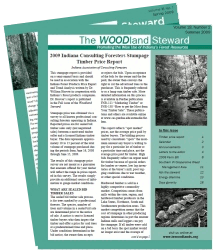 The Department of Forestry and Natural Resources, in partnership with many other organizations, helps produce and mail over 31,000 copies of the Indiana Woodland Steward to woodland owners three times each year. This 16-page, two-color publication includes in-depth articles on forest stewardship and health, invasive species and pests, wildlife habitat management, economics, and more.
The Department of Forestry and Natural Resources, in partnership with many other organizations, helps produce and mail over 31,000 copies of the Indiana Woodland Steward to woodland owners three times each year. This 16-page, two-color publication includes in-depth articles on forest stewardship and health, invasive species and pests, wildlife habitat management, economics, and more.
Results:
Subscribers owned more woods (71.6 ac) for a longer tenure (33 years) than the average woodland owner in Indiana based on data from the National Woodland Owner Survey. As a group, they were also more active managers based on the proportion enrolled in assistance programs and who had a written stewardship plan. Fifty-four percent regularly utilized information from the Woodland Steward. In addition, 51 percent of respondents have implemented at least one practice they read about from The Woodland Steward, potentially impacting an estimated 1.2 million acres of forestland. His use of print media to communicate with woodland owners could be considered expensive, but clearly a large number of woodland owners regularly read and utilize the information making the average investment per landowner much lower.
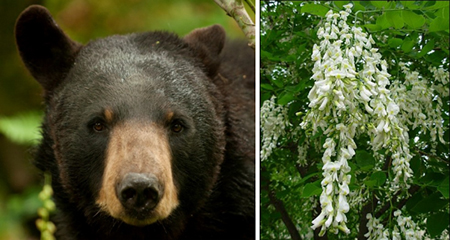 On March 1st and 2nd, the Indiana chapters of The Wildlife Society, American Fisheries Society, and Society of American Foresters are coming together for their annual joint spring conference at the Four Winds Resorts & Marina on Lake Monroe in Bloomington, Indiana. This year’s conference is called Indiana Species On the Edge: Management Issues and Implications and will cover topics such as Indiana species living on the edge of their ranges, challenges researchers face, and solutions being proposed.
On March 1st and 2nd, the Indiana chapters of The Wildlife Society, American Fisheries Society, and Society of American Foresters are coming together for their annual joint spring conference at the Four Winds Resorts & Marina on Lake Monroe in Bloomington, Indiana. This year’s conference is called Indiana Species On the Edge: Management Issues and Implications and will cover topics such as Indiana species living on the edge of their ranges, challenges researchers face, and solutions being proposed.
Pre-registration is required by February 25th in order to plan meals and breaks. For those interested in Continuing Education, attending this conference qualifies as contact hours and The Wildlife Society, American Fisheries Society, and Society of American Foresters‘ Continuing Education pages can provide you with more information. To learn more about the conference, please check out the Indiana Species on the Edge flyer. Further questions can be directed to Sally Weeks at 765.404.2947 or weeksss@purdue.edu. Hope to see you there!
Resources:
Indiana Species On the Edge Flyer
Indiana Species On the Edge Registration
The Wildlife Society – Continuing Education
American Fisheries Society – Continuing Education
Society of American Foresters – Continuing Education
Sally Weeks, Dendrology Instructor and Laboratory Manager
Purdue University Department of Forestry and Natural Resources
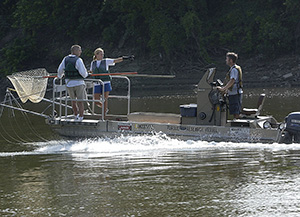
Photo credit: Tom Campbell
As boats enter and exit public bodies of water, they risk transferring aquatic plants, mussels or invertebrates that attach themselves to the bottom of the boat. While this might seem pretty harmless at first, this spreading of aquatic species runs the risk of introducing invasive species into new environments.
Invasive species cause harm to local ecosystems by reproducing exponentially when they are outside of their usual habitat and the organisms that keep their populations in check. They can then cause great damage by feeding on local species and the food they depend on. Once an invasive species is detected, it is oftentimes very expensive and difficult to control. For example, around 1991, the U.S. and Canada spent an estimated $20 million per year to control invasive sea lampreys and restore the trout populations that were damaged by them. In Indiana alone, we spend around $800,000 a year to attempt to control the growth of Eurasian watermilfoil, another nuisance invasive species.
In an attempt to avoid more cases like this in the future, the Indiana Department of Natural Resources (INDNR) is looking for help. Volunteers can sign up to record information about boats and their potential aquatic hitchhikers entering and leaving lakes during times of heavy use. The DNR Division of Fish and Wildlife can take this data and use it for public outreach and planning species management.
Those interested are highly encouraged to sign up on INDNR’s Volunteer Program page.
Resources
Aquatic Invasive Species (AIS), Indiana Department of Natural Resources
DNR Seeks Help Gathering Info on Spread of Aquatic Species, WSBT22
Indiana Invasive Species Council, Purdue Entomology Extension
Invasive Plants, Purdue Agriculture Weed Science
The Education Store, Purdue Extension Resource Center (search “invasive”)
Indiana Department of Natural Resources
The Indiana Department of Natural Resources (INDR) has proposed an idea to the state of Indiana to begin work on a two-mile-long berm in northeast Indiana. The berm will restrict Asian carp from reaching the Great Lakes. It will prevent voracious invasive species from jumping from the Mississippi River watershed during floods to a Great Lakes tributary in Eagle Marsh southeast of Fort Wayne. INDR hopes that work will begin this fall and be completed by September 15, 2015.
View the full article, Work Near on Indiana Berm to Block Asian Carp, from greenbaypressgazette.com.
Resources
Indiana Department of Natural Resources
Asian Carp Movements Project, INDR
Eagle Marsh, Little River Wetlands Project
Invasive Asian Carp May Be Able To Spread Further Than Once Thought, Purdue News
Shocking Asian Carp Out of Midwest Rivers Not a Viable Option, Purdue News
Purdue Agriculture Research: Asian Carp, YouTube video
iTunes-Got Nature?
Got Nature? Podcasts
One of the best parts of spring is seeing all of the wildlife seemingly come to life around us. Unfortunately, that activity can also bring new challenges to homeowners. One of the most common and widespread problems is lawn damage caused by moles.
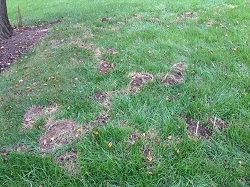
In Indiana, eastern moles cause significant lawn damage. Characteristic signs of damage are the raised surface tunnels (these make your lawn uneven and feel “spongy” when you walk across it) and the dirt mounds created when moles dig deeper tunnels. A single mole can dig many feet of tunnels; one study found a single mole constructed 31 m of surface tunnels in a day.
Biologists actually know very little about moles compared to many species. It is assumed they are territorial and solitary (except during the breeding season), but that has yet to be determined. The only home range study of eastern moles was published in 1976. That study found that the average home range size of male moles was just over 2.5 acres; females had an average home range size of two-thirds of an acre. In reality, there is likely much variation across habitat types and season. Clearly, small yards in urban areas are capable of sustaining many moles.
One of the most effective ways to control moles in the yard is by trapping. It just so happens that the best time to trap them is right now. In May, moles are actively looking for food (mostly earthworms and insects) in the top layer of the soil profile; however, they have not yet had their litter of up to four young. Thus, a little trapping effort now can save you more effort, and less damage, later.
There are a lot of different kinds of mole traps on the market. Which do you choose? Regardless of the type of trap, it should be in good working order. Poorly kept traps that are rusty with loose or broken parts are not worth setting out. In terms of the specific type of trap that you use, it’s really up to you. With types of traps, I use the analogy of computer programs. There are advantages and limitations to most computer programs, but they all get the job done they were intended to do. Different people seem to find different programs easier to work with than others. Perhaps most often, we simply use the first program we learned to use, and as long as it works, there’s not much point in learning another. I think the same is true of traps. We tend to have success with the ones that we first learned or have some experience with using.
The main point is to start trapping now – don’t wait for the damage to get worse. Select relatively straight surface tunnels for trap locations. If you only have one trap at your disposal, you may want to also mark a couple other potential trapping locations. Collapse these locations by stepping on them and marking them with a pin flag. If you aren’t having success catching a mole in your initial location, you can try moving to one of these if the tunnels are repaired. It may be that you initially chose a tunnel that was not a primary tunnel. However, it also may mean that your trap was not set properly.
Finally, you may come across some references that will direct you to check the traps frequently. While this is absolutely critical for live traps, it is not for mole traps since they are kill traps. There is no requirement to check them regularly other than to see if you have a mole. However, a trap with a dead mole won’t catch anything else. This is one reason why setting several traps is better if you have access to them. If you don’t catch a mole within two days, then you should consider moving locations or resetting the trap. When you catch a mole, keep setting traps until you don’t catch them. Most homeowners have problems with several moles and not simply one mole.
For more detailed information about controlling moles, see Wildlife Conflict Management – Moles, Purdue Department of Entomology.
Resources:
Moles, The Education Store, Purdue Extension resource center
Dealing With Mole Damage in Your Yard, Video, Purdue-Extension Forestry and Natural Resources (FNR) YouTube Channel
Adjuvants and the Power of the Spray Droplet: Improving the Performance of Pesticide Applications, The Education Store
Preventing Wildlife Damage – Do You Need a Permit?, The Education Store
Attract Hummingbirds to Your Yard, Video, Purdue Extension – FNR YouTube Channel
How to Stop Woodland Animals from Digging in Your Flower Pots, Video, Purdue Extension – FNR YouTube Channel
Brian MacGowan, Extension Wildlife Specialist
Department of Forestry and Natural Resources, Purdue University
 A recent discussion about Asian carp as a food source has generated some concerns about the level of contamination in their fillets, and thus, whether or not they are safe to eat. Several Indiana agencies cooperate to evaluate the risks of fish consumption to the public; the agencies include the Indiana Department of Natural Resources (INDNR), Indiana Department of Environmental Management (IDEM), Indiana State Department of Health (ISDH) and Purdue University. Most of the fish assessed for contaminants are those that are regularly caught by anglers. Numerous catfish, bass, sunfish and sucker species are commonly included in tissue surveys (see links below for more info). Indiana then divides people into two risk groups: 1) men (over 15 years) and women beyond childbearing age (typically 45 years or older) and 2) women pregnant or capable of becoming pregnant and children under 15. The second group is considered the sensitive group, and allowable contaminant levels (that is, the amount of fish that is safe to consume) are set significantly lower.
A recent discussion about Asian carp as a food source has generated some concerns about the level of contamination in their fillets, and thus, whether or not they are safe to eat. Several Indiana agencies cooperate to evaluate the risks of fish consumption to the public; the agencies include the Indiana Department of Natural Resources (INDNR), Indiana Department of Environmental Management (IDEM), Indiana State Department of Health (ISDH) and Purdue University. Most of the fish assessed for contaminants are those that are regularly caught by anglers. Numerous catfish, bass, sunfish and sucker species are commonly included in tissue surveys (see links below for more info). Indiana then divides people into two risk groups: 1) men (over 15 years) and women beyond childbearing age (typically 45 years or older) and 2) women pregnant or capable of becoming pregnant and children under 15. The second group is considered the sensitive group, and allowable contaminant levels (that is, the amount of fish that is safe to consume) are set significantly lower.
It is important to recognize that there are differences in allowable contaminants among population groups mentioned above, and it is equally important to recognize that the same fish species can have different amounts of contaminants in different water bodies. Asian carp are a riverine species that frequently travel long distances, and as such, they are exposed to varying levels of contaminants. Indiana and many other states try to minimize the effects of variation in individual fish fillet by combining tissue from multiple individual fish and analyzing it as a composite. Sampling the tissue as a composite reduces the risk of a heavily contaminated fish or a fish with little contamination, giving a false impression of the risk. By combining the fillets, Indiana also saves money by not analyzing large amounts of single fillets. Indiana does divide the fish into a couple of size classes for each composite because contamination increases significantly as fish size increases. They have yet to begin testing Asian carp fillets, at least partially because of their difficulty to capture using traditional fish survey techniques.
Although most states have not started regularly testing Asian carp, there has been some published research evaluating Asian carp fillets and comparing their contaminants to other species caught in the same location. Not surprisingly, the results of the research found that Asian carp have different concentrations of contaminants depending on where they are found, and they have different levels than other species of fish including common carp. Common carp have a completely different diet than Asian carp, so it is not surprising that contamination levels are different. Like most other fish, the most common problems associated with Asian carp are Mercury and PCBs. However, where the research was conducted in Illinois and Missouri, the recommended restriction on consumption was typically one meal per week for the most sensitive groups. Most studies have demonstrated that larger fish tend to have higher concentrations in their tissues than smaller fish found in the same environments. This relates to the way Mercury and PCBs bioaccumulate in tissues – the longer a fish is around, the more contaminants per gram we would expect them to contain. This is not to say that Asian carp in Indiana is safe for that level of consumption or that it even contains the same amount of contaminants as in other states. It still needs to be evaluated by the state, but studies cited below have shown that for the most part, Asian carp are likely no riskier to consume than most of the fish species that Indiana currently evaluates.
Resources
Fish Consumption Advisory
Indiana State Department of Health
Asian Carp Solutions: Take Them to Market
Illinois-Indiana Sea Grant (IISG) Newsroom
No Bones About It: New Video Lays Out Easy Steps For Filleting Tasty Asian Carp
Illinois-Indiana Sea Grant (IISG) Newsroom
Published Papers
Levengood, J.M., D.J. Soucek, G.G. Sass, A. Dickinson, and J.M. Epifanio. In press. Elements of Concern in Fillets of Bighead and Silver Carp From the Illinois River, Illinois. Chemosphere 2013.
Rogowski, D.L., D.J. Soucek, J.M. Levengood, S.R. Johnson, J.H. Chick, J.M. Dettmers, M.A. Pegg, and J.M. Epifanio. 2009. Contaminant Concentrations in Asian Carps, Invasive Species in the Mississippi and Illinois Rivers. Environmental Monitoring and Assessment
Resources:
Walleye Farmed Fish Fact Sheet, The Education Store, Purdue Extension’s resource center
Pacific White Shrimp Farmed Fact Sheet, The Education Store
Yellow Perch Farmed Fish Fact Sheet, The Education Store
Tilapia Farmed Fish Fact Sheet, The Education Store
Rainbow Trout Farmed Fish Fact Sheet, The Education Store
American Paddlefish, The Education Store
A Guide to Small-Scale Fish Processing Using Local Kitchen Facilities, The Education Store
Aquaculture Family Coloring Book Development, The Education Store
Eat Midwest Fish, Illinois-Indiana Sea Grant online resource hub
Aquatics & Fisheries Videos, Purdue Extension-Forestry and Natural Resources YouTube Channel Playlist
Department of Forestry and Natural Resources (FNR)
Illinois-Indiana Sea Grant (IISG)
Purdue University
Since the Polar Vortex subsided, there has been quite a bit of buzz about the Emerald Ash Borer (EAB), an exotic beetle that is killing ash trees across Indiana and the U.S., being killed by the multi-day sub-zero temperatures we experienced here in Indiana and elsewhere. Some recent research (the full paper can be accessed here) predicts that when EAB larvae reach 0°F, 5% will die; at -10°F, 34% will die; at -20°F, 79% will die; and at -30°F, 98% will die. Based on some -15°F temperatures here at the Purdue West Lafayette campus, we might expect around 50% of the EAB will die, but some additional points need to be considered.
EAB larvae are located overwinter under the bark in infested ash trees, so the bark may offer some insulation. Snow is also an excellent insulator, so the lower trunk of ash trees in deep snow or drifts may not get as cold as ambient air temperatures. Some trees in town or near structures may remain warmer due to heat radiating or escaping from buildings. The message is, unfortunately, that the cold weather we experienced was probably not enough to solve our EAB problems.
It is good news that some of the population was probably killed by the cold weather, leaving fewer larvae to damage ash trees next spring. This will be a temporary setback for the borer, since one of the biological strengths of insects is their capacity to reproduce and grow populations quickly. Further north in places like Minnesota, the news for the ash trees may be better where temperatures below -30°F may have killed most of the larvae, providing some additional time to prepare for the EAB onslaught. Here in Indiana, we need to continue to monitor, prepare and act to limit the damage EAB will do. Some basic steps include:
Don’t move firewood – Firewood can harbor EAB and several other serious tree pests and spread them to new areas.
Learn to identify ash trees, EAB and the symptoms of EAB damage.
Learn about EAB control techniques.
Learn how to decide if your ash tree should be treated with insecticide to protect it from EAB or removed and possibly replaced with another tree species.
Work with your neighbors to monitor and manage the ash trees in your area.
Purdue Extension offers science-based recommendations to help you manage the EAB threat at http://extension.entm.purdue.edu/EAB/.
Lenny Farlee, Sustaining Hardwood Extension Specialist
Hardwood Tree Improvement and Regeneration Center (HTIRC)
Forestry and Natural Resources, Purdue University
Determining what causes holes in lawn and landscaping can be a challenging endeavor for any homeowner. The size of the hole, the presence of excavated dirt and the timing of activity are all good clues to consider. Recently, I had several holes along my driveway and sidewalk that perplexed me. I’m no stranger to holes in my yard. I’ve been combating moles in my yard (we will save that for another post) and had recently observed dead mice and shrews in my driveway. I also have many chipmunks and gray squirrels around the yard.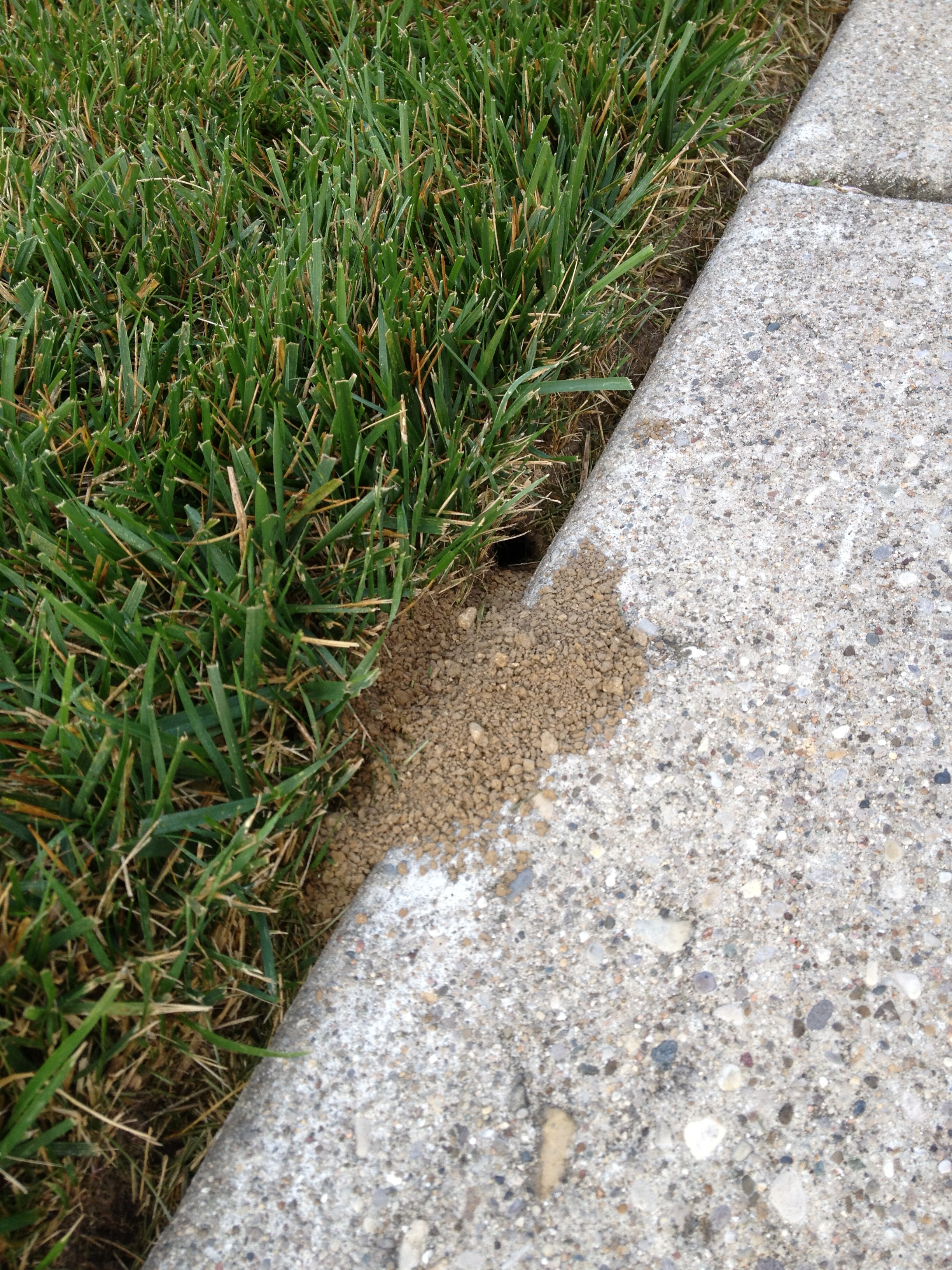 All of these can make holes of one type or another. However, these new holes looked different. They were clearly a tunnel/burrow with an entrance of 1.5 inches. Squirrels dig holes to bury/dig nuts or to feed on small plants. Chipmunks make 1.5 inch holes, but they carry the cast soil away in their mouths which results in a less conspicuous hole. Shrews and voles will excavate holes and tunnels, but these looked different. Voles usually are found in areas with overhead cover such as densely planted landscaping beds, areas with ground ivy or similar plants and beds with think mulch. These holes were exposed far from cover. So what were they?
All of these can make holes of one type or another. However, these new holes looked different. They were clearly a tunnel/burrow with an entrance of 1.5 inches. Squirrels dig holes to bury/dig nuts or to feed on small plants. Chipmunks make 1.5 inch holes, but they carry the cast soil away in their mouths which results in a less conspicuous hole. Shrews and voles will excavate holes and tunnels, but these looked different. Voles usually are found in areas with overhead cover such as densely planted landscaping beds, areas with ground ivy or similar plants and beds with think mulch. These holes were exposed far from cover. So what were they?
It just so happens I was at a colleague’s house recently, and he mentioned all the cicada killers he has around the house. He literally had dozens of holes in areas with exposed soil just like the ones I observed at home. To my delight, I finally had the answer to my question.
Cicada killers are large wasps but unlikely to sting. Purdue’s Department of Entomology has more on cicada killers free downloadable pdf, Household and Structural, Cicada Killers.
Brian MacGowan, Wildlife Extension Specialist
Department of Forestry and Natural Resources
Purdue University
Recent Posts
- Spotted Lanternflies on the Move! – Purdue Landscape Report
Posted: July 30, 2024 in Forestry, Invasive Animal Species, Invasive Insects, Wildlife, Woodlands - Look Out for Invasive Carp in Your Bait Bucket – Wild Bulletin
Posted: March 31, 2024 in Alert, Aquaculture/Fish, Aquatic/Aquaculture Resources, Invasive Animal Species, Wildlife - State of Indiana Proclamation-Invasive Species Week 2024
Posted: February 19, 2024 in Alert, Forestry, Forests and Street Trees, Invasive Animal Species, Invasive Insects, Invasive Plant Species, Urban Forestry, Wildlife, Woodlands - Invasive Carp Removal on the Ohio River, Wild Bulletin
Posted: December 8, 2023 in Alert, Aquaculture/Fish, Aquatic/Aquaculture Resources, Invasive Animal Species, Wildlife - Join the fight: Help Stop Aquatic Invasive Species – MyDNR
Posted: July 14, 2023 in Alert, Aquaculture/Fish, Aquatic/Aquaculture Resources, How To, Invasive Animal Species, Wildlife - Summer Bat Roost Monitoring Project – MyDNR
Posted: May 8, 2023 in Alert, How To, Invasive Animal Species, Wildlife - Aquatic Invasive Species-Wild Bulletin
Posted: July 14, 2022 in Aquaculture/Fish, Aquatic/Aquaculture Resources, How To, Invasive Animal Species, Wildlife - New Video Series Highlights Great Lakes Areas of Concern-IISG
Posted: July 7, 2022 in Aquaculture/Fish, Aquatic/Aquaculture Resources, Great Lakes, Invasive Animal Species, Wildlife - Cuban Treefrog Identified in Indiana
Posted: June 24, 2022 in Invasive Animal Species, Wildlife - Prevent the Spread of Aquatic Invasive Species, Wild Bulletin
Posted: April 28, 2022 in Aquaculture/Fish, Aquatic/Aquaculture Resources, Invasive Animal Species, Invasive Insects, Invasive Plant Species, Wildlife
Archives
Categories
- Alert
- Aquaculture/Fish
- Aquatic/Aquaculture Resources
- Ask the Expert
- Christmas Trees
- Community Development
- Disease
- Drought
- Forestry
- Forests and Street Trees
- Gardening
- Got Nature for Kids
- Great Lakes
- How To
- Invasive Animal Species
- Invasive Insects
- Invasive Plant Species
- Land Use
- Natural Resource Planning
- Nature of Teaching
- Plants
- Podcasts
- Ponds
- Publication
- Safety
- Spiders
- Timber Marketing
- Uncategorized
- Urban Forestry
- Webinar
- Wildlife
- Wood Products/Manufacturing
- Woodland Management Moment
- Woodlands
